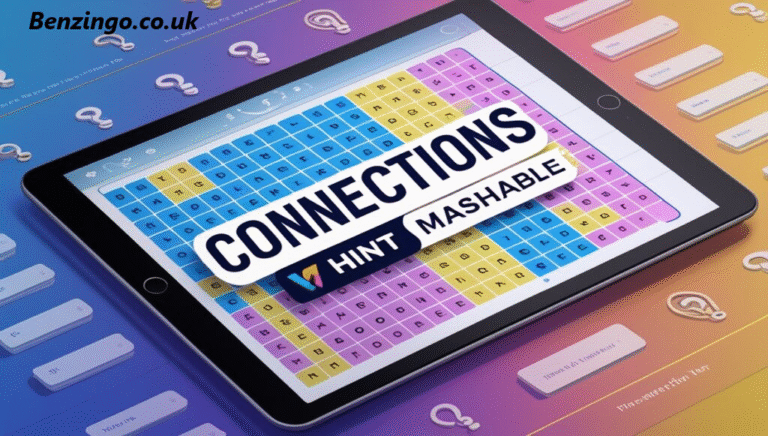Introduction
The New York Times Connections puzzle has quickly become a daily ritual for word-game aficionados. Every day, you’re presented with 16 seemingly random words and tasked with identifying four thematic groups of four words each. It’s engaging, thought provoking, and often delightfully frustrating. That’s where Connections Hint Mashable enters, offering effective, non-spoiler nudges that guide you toward discovering the solution on your own terms.
What Are “Connections Hint Mashable” Clues?
Connections Hint Mashable employ a layered and thoughtful hint structure they begin broad and gradually become more specific, all while respecting the solver’s satisfaction of independent discovery. Here’s how they typically unfold:
- Category Hints: General themes such as “colors, movie genres,” or “things you wear.”
- Contextual Cues: Background Connections Hint Mashable to clarify ambiguous words.
- Difficulty Indicators: Subtle markers like “easiest” or “tricky” reflecting yellow (easy) to purple (hard) groupings.
Why Mashable’s Hint System Stands Out
Unlike spoiler-heavy guides, Mashable strikes a balance preserving the puzzle’s integrity while easing cognitive friction. Their approach emphasizes learning, not just winning. Among the key strengths:
- Strategic nudging: Not giving away the answer, but prompting a direction.
- Layered guidance: From vague to focused, you choose how much help to view.
- Supporting all player levels: Equally helpful for novices and prost.
- Promoting critical thinking: Encourages noticing subtle linguistic ties.
- Retaining fun: Players feel assisted, not assisted too much.
Deep Dive: How the NYT Connections Puzzle Works
Before we dig into strategies, knowing the puzzle’s structure helps you wield hints effectively:
- 16-word grid, to be grouped into four thematic sets.
- Color-coded difficulty levels:
- Yellow (easiest)
- Green
- Blue
- Purple (hardest, often involving wordplay or abstract connections Hint Mashable).
- Limited mistakes allowed (commonly 4) underscores the value of precision and hint-supported reasoning.
Smart Strategies for Using Mashable Hints Effectively
- Start with a general scan: Look for easy groupings colors, animals, categories that pop out.
- Check category hints before making picks: Align your instincts with the direction they point.
- Build groups systematically: Begin with the easiest clusters (often yellow or green).
- Use process of elimination: If three words unmistakably fit, the fourth usually follows.
- Revisit hints after partial grouping: New context often reveals hidden connections Hint Mashable.
- Balance intuition with logic: Don’t overthink; trust subtle linguistic patterns.
- Reflect post-solve: Noting themes or tricky categories boosts future performance.
Illustrative Example: Mashable’s Guided Hint Journey (Fictional Scenario)
- Category Hint: “Think of clothing items” nudges toward attire themed group.
- Contextual Cue: “One of these is often worn on feet in summer helps pinpoint words like Sandal, Flip, Mule, Loafer.
- Layered clarity: If stuck, a second tier Connections Hint Mashable might say Excludes footwear worn in winter.
This method avoids spoiling the puzzle but scaffolds your thinking intelligently.
The Cognitive Benefits of Using Mashable Hints
Leveraging this hint system does more than help you solve puzzles it improves your cognitive skills:
- Pattern Recognition: Repeated exposure trains you to spot nuance.
- Word Association: Sharpened by noticing subtle or multi-layered links.
- Problem Framing: Learning to group by themes, formats, or systematic clues.
- Reflective Thinking: Evaluating how you arrived at connections deepens understanding.
Community Insights and Comparisons
Here’s how Connections Hint Mashable stacks up alongside common alternatives:
| Resource | Style | Strengths | Limitations |
|---|---|---|---|
| Mashable | Layered, non-spoiler, playful | Balanced guidance, daily updates | May need pairing with practice |
| Reddit communities | Crowd-sourced, fast | Diverse perspectives, real-time | Spoiler risks, variable clarity |
| YouTube/tutorials | Visual, step-by-step breakdowns | Great for visual learners | Often spoils full answers |
| Puzzle blogs (TechRadar, CNET, etc.) | Structured walkthroughs | Detailed breakdowns, archives | Some reveal complete solutions |
Mashable is favored for its middle-ground helpful, but not hand-holding.
Common Pitfalls and How to Navigate Them
- Over-reliance on hints: Use them sparingly; they are meant to guide, not replace reasoning.
- Ignoring red herrings: Mashable’s hints help you sidestep decoys but stay aware of misleading words.
- Stuck in early stages: If stalling, take a short break and revisit with fresh perspective.
- Unbalanced grouping: Avoid intuitive bias check across all words for alternative fits.
Making Mashable Hints Work for You: A Daily Habit
- Begin your day with a fresh solve using hints as needed.
- Track your strategy: note which hints helped and refine your approach.
- Join forums for discussion: NYTConnections often broadens your perspective.
- Review archived puzzles on Mashable to recognize recurring puzzle patterns.
Conclusion
Connections Hint Mashable serves as a beautiful blend of guidance and challenge. It preserves the joy of discovery while quietly steering you toward the haha moment. Through layered hints, theme nudges, and puzzle insight, Mashable enhances your NYT Connections experience deliberately.


